
As with many things in life, one person’s definition of "ideal” will differ from another’s. With an aquarium, it not only has to be ideal for the hobbyist (and family), but the tank also needs to be ideal for whatever fish and/or invertebrates you want to keep. In this article, I will talk about different ideal aquariums, from those for first-time hobbyists to advanced ones and for freshwater and marines.
When it comes to fish and aquariums, one person’s ideal could very easily be another’s horror show. For example, across from my desk here, I have a 300-gallon heavily planted freshwater tank with a 125-gallon sump. For me, that is an ideal tank. Good friends were over last week, and the wife’s take on the tank is that it is frightening having that much water on the second floor of the house—and she is much happier with the 20-gallon setup we gave them a few years ago.
The "ideal” aquarium basically has a few limitations. These include space available, dollars available, time the hobbyist wants to devote to the aquarium, and the attitude of the spouse/intimate other (from here on I will use "spouse” to encompass both) about fish tanks in general and the "ideal,” in specific. A couple of examples for illustrative purposes:
When you decide to get your first aquarium, the first thing to do is to define where the aquarium will go in your home, how much money you will spend on it, and who will take care of the tank. With those guidelines in mind, the next thing to do is to find a good local fish store. This can be an independent or one of the big box stores. Talk with friends who have fish tanks, and find out where they go. Attend a meeting at your local aquarium club. Don’t start by surfing the web, as you will be overwhelmed. When you go to chat with your local fish stores, don’t go on a weekend day; they will be very busy and won’t be able to spend the time you want them to with you. Drop in on a Wednesday, late afternoon or evening—store traffic should be slow, and the staff will have more time to speak with you.
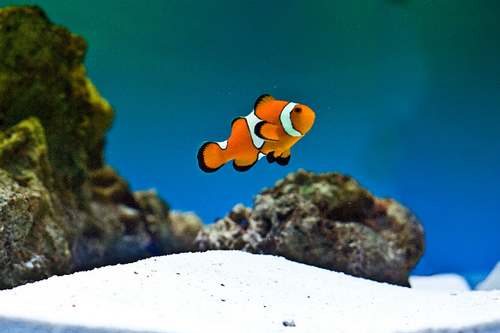
Amphiprion ocellaris clownfish are widely captive bred. Photo by Anita Ritenour/Flickr
Explain to the sales person that you are a first-time hobbyist, and define the limitations of your venture—space, money, time, etc. If the store is one you should patronize, the salesperson will spend time helping you get started in our wonderful hobby. If they bring a 10-gallon starter kit to the counter for you and tell you that everything you need to know is in there, find another store. It used to be the case that the recommendation was to start with a freshwater tank, and when you get your sea legs under you, advance to a marine tank. That is no longer necessary. We now know enough about keeping a marine tank that a first-time hobbyist can be successful with his or her first tank being saltwater; if fact, the first-timer may be more successful because marine fish are more expensive and folks seem to pay more attention to a marine tank.
Before moving along to the options for you, please allow me a quick mention of what NOT to start with.
Freshwater options include:
Saltwater options include:
Ever since I had my stores back in the last century (I may be old, but I got to see the cool bands), the standard aquarium starter kit has been a 10-gallon tank. These are marketed, especially by the big stores, purely on price, and they make it pretty inexpensive to get started with keeping fish. However, the failure rate with these 10-gallon starter kits is pretty high. They often do not have a heater, and unless you limit yourself to cold-water fish—danios, white clouds, etc.—a store may sell you fish that need a heater. If you are going to start with a 10-gallon tank, please make sure it has, or that you add, a heater. Better yet, go for a 20-gallon tank setup. Yes, it will be more expensive than the 10-gallon starter kit, but you will have twice as much water and, therefore, there will be twice as much forgiveness of mistakes that all first-time fishkeepers make.
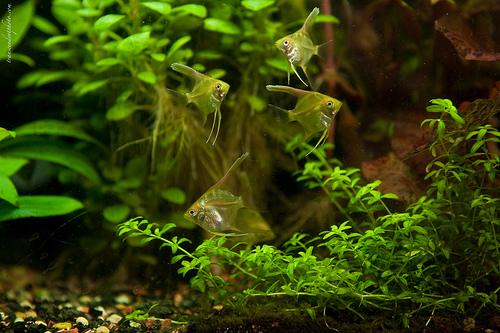
Angelfish with live plants. Photo by Dariusz/Flickr
If you want to keep live plants, be sure to tell the salesperson, to make sure the aquarium light is sufficient to grow live plants. Gravel and ornaments are completely your choice; just don’t put anything into your tank that you did not get from the store, such as beach or river stones, pieces of wood, etc. Items collected from nature may have unwanted life forms hitching a ride on them and then wreaking havoc in your tank.
Goldfish are beautiful, and they have been kept by hobbyists for thousands of years. They come in many lovely shapes and colors, and they will do fine at room temperature without a heater. However, goldfish grow quickly, and they will eventually need 5 to 8 gallons of water per fish. They also tend to be really messy, and the best filter for a goldfish tank is an outside canister filter or at least a hang-on-back (hob) filter. Clean the filter often—just the mechanical portion (floss or sponge). Use either number two gravel or fine sand. Large-size gravel will allow food and detritus to slip between the grains and make a big mess. Hard-leaved plants are best—Anubias spp. and java ferns are ideal. And finally, do not start with the small, cheap "feeder” goldfish. These fish are very stressed, and if they do survive, they will get big—like 6 inches or more in a year or so. Stay with the fancy varieties—orandas, ryukins, telescopes, etc.
After most hobbyists have kept their first tanks for a while (a "while” could be a week or a year or anything in between), they usually get the disease called MTS—multiple tank syndrome. A good friend of mine at United Pet Group (the parent company of Tetra, Marineland, etc.) told me that 50 percent of all first-time fishkeepers do not have their tank after a year—but that 60 percent of those who do still have their first tank will have started at least one more tank. This is where species tanks start appearing. A hobbyist decides that he/she really likes one kind of fish and wants to start a new tank just with those fish. A couple examples of species tanks include:
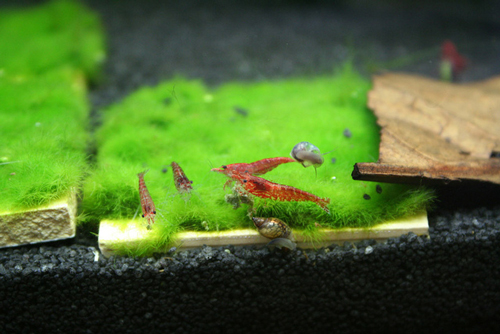
freshwater shrimp tank. Photo by Konstantin Matern/Flickr
I think all tanks should have live plants, and all of my tanks, except where I have breeding angelfish, have live plants. If you keep big cichlids, including Africans, or fish that eat plants voraciously, you may want to rethink keeping live plants. The two things to think about with a planted tank are:
In general, I like to keep it simple when it comes to live plants, and I suggest the following:
The equipment, and our knowledge, have both improved so much that it is easy to keep a marine tank as your first aquarium. There are a number of packaged nano tanks that will do well with a few soft corals and one or two tiny blennies or gobies. These very small tanks usually do not contain any heater or any protein skimming, so the livestock has to be very limited. Your local fish store will be able to tell you how to keep a marine nano as a starter tank.
There are, however, a variety of excellent, larger-packaged marine tanks. These larger tanks include—in addition to better lighting—a heater, some water movement pumps, small mechanical filtration (usually just a thin piece of sponge) and a protein skimmer. With all of those items, a packaged marine kit can be an excellent starter tank. I have had great results with all of the Red Sea models. The most important key to success with a first marine tank is to buy only aqua cultured fishes and invertebrates. These tend to be heartier and have not undergone the stress of specimens taken from the wild. Fortunately, there are plenty of aqua cultured fish around, with more coming out all the time.
Top 10 Most Popular Captive Bred Marine Fish
10 Saltwater Fish Beginning Fishkeepers Should Avoid
This is the most popular type of marine tank, and a FOWLR tank will do very well if you follow a few guidelines.
For many hobbyists, a reef tank is the ultimate ideal aquarium. The notion of having a "slice of the reef” in your living room can be very alluring. Beautiful fish, interesting corals, clams and other invertebrates—what could be better? We surely have the knowledge and the products necessary for maintaining a true reef aquarium. LED lighting is available to provide all the light that a reef tank needs, but there will always be a few diehards who will go to their graves clutching their metal halides. We have the proper foods for corals and other inverts as well as for all of the fish. A reef tank is well within the sight of any dedicated fishkeeper. I stress the word "dedicated,” as a successful reef tank requires lots of time and a fair amount of money. You need to monitor all of the parameters of water chemistry regularly, at least two or three times a week, and be prepared to add the requisite additives to keep the parameters where they should be, either by hand or using dosing pumps. Different foods need to be fed sparingly but often. Reef tanks are gorgeous, but I sincerely urge you to think it through before you make the commitment. Make sure you are ready.
Fish-only Versus Reef Tank
Reef Aquarium Setup Guide
There are plenty of very interesting fish and invertebrates (both fresh and marine) that cannot be kept together in a large tank with other animals. Some potential inhabitants that come to mind are the many varieties of freshwater shrimp and crayfish, marine goby/shrimp pairs, mantis shrimp, etc. To keep a variety of animals in a single place and system, there are "cube systems” available. These started out being for marine wholesalers and retail fish stores, but now they are available for hobbyists. The systems consist of a number of levels of individual cubes, all tied together to the same filtration/heating system in a sump below. Water is pumped up and into all of the cubes and then returns to the sump. These are very nice systems if you want to keep a variety of small animals.
Not to be facetious (which is one of the few words in the English
language that has all of the vowels appearing once only and in the
correct order—aeiou), but it can be argued that fish do not need any
plants. After all, go into any local fish store and take a look at the
tanks that they sell their fish from. I can pretty much guarantee you
that those tanks will not have any live plants in them. Live plants in
store tanks will get destroyed in the process of catching the fish, and
the fish will eat them anyway.
There is a difference between fish
that need plants and fish that need vegetable matter in their diet. No
fish really need plants, but many need vegetable matter in their diet.
Fish that need plant matter in their diet can be kept healthy by feeding
them prepared foods that are heavy in plant matter and offering them
vegetables as a regular part of their diet. Blanched zucchini, romaine
lettuce and nori from an Asian foods store will meet their vegetable
needs. Feeding plant matter to fish that require it is easy and should
always be done.
My unbiased, and correct, view of live plants is that
any tank looks better with live plants, and the fish will do better.
Every tank I have (and I have many), except tanks for breeding
angelfish, is densely planted with live plants. Some fish really do need
live plants. These include most of the small schooling fish, such as
tetras, rasboras and the like. These fish need the safety of a thicket
of live plants to retreat into or leaves floating on the surface that
they can hide under. The more places for fish to hide, the safer they
will feel and the more they will be out in the open where you can see
them.
Many fish need vegetable matter in their diet, and while those
fish are very pleased to be able to chomp on live plants, it will be
difficult to keep soft plants with these fish for any length of time.
Bunch plants, such as Egeria spp., Cabomba spp., will have a tough time
keeping up their growth if there are fish such as silver dollars,
mollies or clown loaches in the tank.
Live plants offered for use in aquariums vary greatly, and I would divide them into four groups.
Lots of fish need vegetable matter in their diet, but this
is different from needing live plants in their aquarium. For fish like
mollies, platies and swordtails, silver dollars and loaches, if there
are soft live plants in their aquarium, they will happily chomp down on
them. To keep them equally happy, and in better shape, it is best simply
to feed them a variety of dry prepared foods that are high in vegetable
matter (especially spirulina algae), and offer them pieces of blanched
Romaine lettuce, zucchini or melon rinds.
As I hope you can see from this article, the number of different ideal aquariums is only limited by your constraints of space, money, time and living arrangements. Please allow me to leave you with some general principles of fishkeeping that apply universally.
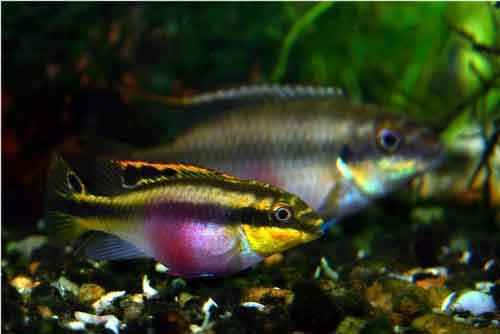 Kribensis Care and Breeding
Kribs are small, colorful cichlids that have become a staple
Kribensis Care and Breeding
Kribs are small, colorful cichlids that have become a staple
 Aquarium Fish Hiding Places
Imagine having to spend an extended period in a room w
Aquarium Fish Hiding Places
Imagine having to spend an extended period in a room w
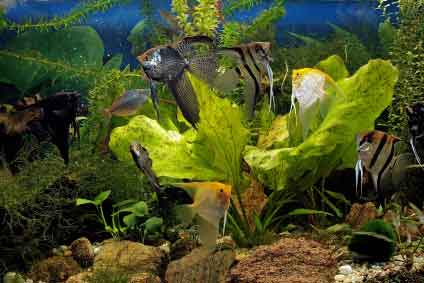 Hiding Fish
A common complaint, especially with new hobbyists, is, &
Hiding Fish
A common complaint, especially with new hobbyists, is, &
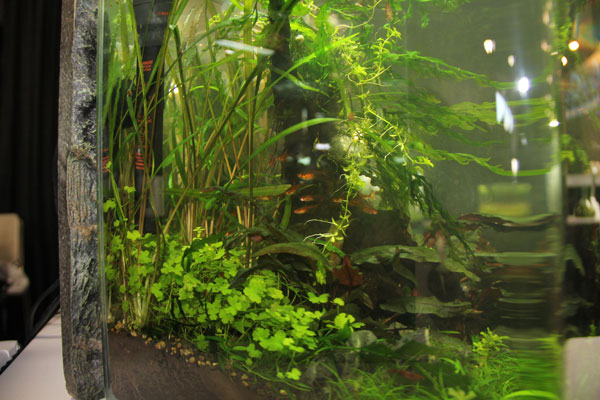 Innovations in the Aquarium Hobby
Fishkeeping has experienced a lot of progress throughout the
Innovations in the Aquarium Hobby
Fishkeeping has experienced a lot of progress throughout the
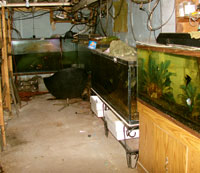 Custom Aquarium Setup
I wonder, is your setup like mine? The answer is proba
Custom Aquarium Setup
I wonder, is your setup like mine? The answer is proba
Copyright © 2005-2016 Pet Information All Rights Reserved
Contact us: www162date@outlook.com